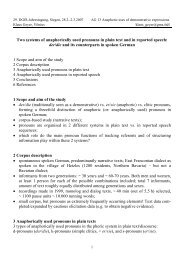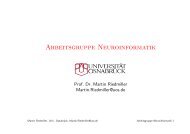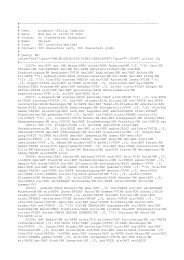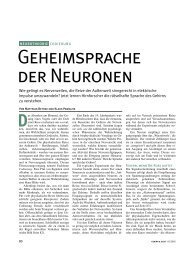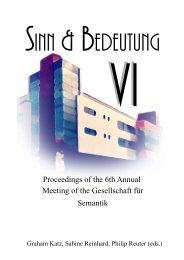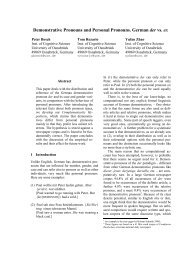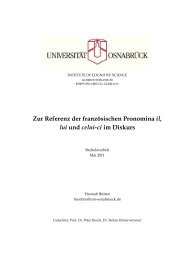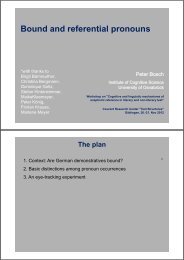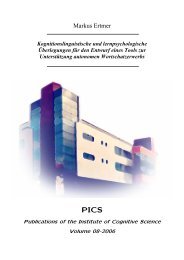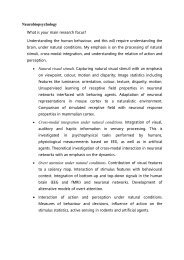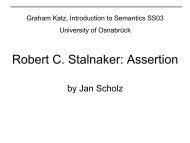Restriktion der Alternativen
Restriktion der Alternativen
Restriktion der Alternativen
Erfolgreiche ePaper selbst erstellen
Machen Sie aus Ihren PDF Publikationen ein blätterbares Flipbook mit unserer einzigartigen Google optimierten e-Paper Software.
6 Zusammenfassung<br />
200<br />
Carla Umbach<br />
In <strong>der</strong> Diskussion zur Semantik von Fokus war man sich immer darüber im klaren, dass die<br />
<strong>Alternativen</strong>menge kontextuellen <strong>Restriktion</strong>en unterliegt, und dass man diese Beschränkungen<br />
erfassen muss, will man z.B. korrekte Vorhersagen über den Quantifikationsbereich fokussensitiver<br />
Adverbien machen. In diesem Papier wurde gezeigt, daß anaphorische Bezüge<br />
eine entscheidende Rolle für die <strong>Restriktion</strong> <strong>der</strong> <strong>Alternativen</strong>menge spielen. Daraus folgt, daß<br />
eine adäquate Semantik für Fokus auf Diskursebene realisiert werden muß – auch Fokus im<br />
Sinne von <strong>Alternativen</strong>auswahl ist ein diskursbezogenes Phänomen. Es wurde gezeigt, wie<br />
<strong>Alternativen</strong>mengen als Diskursreferenten repräsentiert werden können, wie anaphorische<br />
<strong>Restriktion</strong>en sich damit verbinden und wie solche Alternativ-Referenten ihrerseits durch die<br />
NP die an<strong>der</strong>e(n) [p] aufgegriffen werden können. Die Diskussion beschränkte sich auf definite<br />
Nominalphrasen mit Fokus in <strong>der</strong> Kopfdeskription und in Modifikatoren. Offen bleibt,<br />
wie sich Foki auf Determinatoren, in Indefiniten und bei Verben diskurssemantisch repräsentieren<br />
lassen und welchen <strong>Restriktion</strong>en solche <strong>Alternativen</strong>mengen unterliegen.<br />
Literatur<br />
Eckardt R. (1996): Intonation und Predication. Arbeitspapiere des SFB 340. Universität Düsseldorf, Seminar für<br />
Sprachwissenschaft.<br />
Farkas, D. (2000): Varieties of Definites. Talk given at the Antwerp Colloquium on the Syntax and Pragmasemantics<br />
of Noun Phrases, February 2000. (cf. www.ling.ucsc.edu/~farkas)<br />
Grosz, B., Joshi, A., Weinstein, S. (1995): Centering: A Framework for Modelling the Local Coherence of Discourse.<br />
Computational Linguistics 21 (2), 203-225.<br />
Halliday, M.A.K (1967): Notes on transitivity and theme in English. Part 1 and 2. Journal of Linguistics 3, 37-<br />
81, 199-244.<br />
Haviland, S.E., Clark, H.H. (1974): What s new? Acquiring new information as a process of comprehension.<br />
Journal of Verbal Learning and Verbal Behavior, 13, 515-521.<br />
Hawkins, J. (1991): On (in)definite articles: implicatures and (un)grammaticality prediction. Journal of Linguistics<br />
27, 405-442.<br />
von Heusinger, K. (1998): Association with Focus in Definite NPs. Linguistic Research Center UCSC, LRC-98-<br />
01.<br />
Kamp, H., Reyle, U. (1993): From Discourse to Logic. Kluwer Academic Publishers.<br />
Kamp, H. (2000): Presupposition Computation and Presupposition Justification: One Aspect of the Interpretation<br />
of Multi-Sentence Discourse. Tutorial in Computational Linguistics.<br />
Krifka, M. (1993): Focus and Presupposition in Dynamic Interpretation. Journal of Semantics 10.<br />
Krifka, M. (1999): Frameworks for association with focus. Workshop "Intonation and Interpretation", ESSLLI<br />
99, Utrecht.<br />
Krifka, M. (ms.): Association with Focus Phrases.<br />
Lang, Ewald (1984): The semantics of coordination. SLCS 9, Amsterdam, Benjamins.<br />
Meinunger, A. (1995): Focus dependencies and the Or<strong>der</strong>ing of Context Sets. Proceedings of the Goettingen<br />
Focus Workshop, Arbeitspapiere des SFB 340, Nr.69.<br />
Preuss, S., Schmitz, B., Hauenschild, Ch., Umbach, C. (1994): Anaphora Resolution in Machine Translation. In:<br />
Ramm, W. (Hrg.): Text and Context in Machine Translation. Studies in Machine Translation and Natural<br />
Language Processing, Vol.6, 29-52.<br />
Rooth, M. (1992) A Theory of Focus Interpretation. Natural Language Semantics 1.<br />
van <strong>der</strong> Sandt, R. (1992): Presupposition Projection as Anaphora Resolution. Journal of Semantics, 9, 333-377.<br />
Schwabe, K. (2000): Coordinative Ellipsis and Information Structure. In: Schwabe, K. & Zhang, N. (eds.): Ellipsis<br />
in Conjunction. (= Lingustische Arbeiten 418) Tübingen, 247-269.



